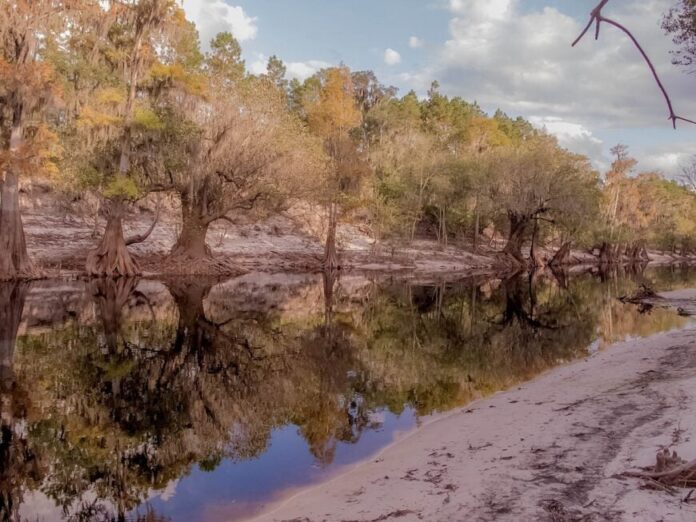North Florida is dotted with crossroads where sand-spurs outnumber streetlights and the nearest chain coffee shop sits a county away. These places reward patience: follow a two-lane highway past pine flats, roll down the windows, and a hush settles in that city dwellers seldom hear.
We gathered 25 towns—each lightly populated, wrapped in wild land, and blessed with a quirk or two that keeps it firmly off the beaten track. From river hamlets hemmed in by national forest to hilltop communities nudging the Alabama line, the region proves seclusion still exists east of the Mississippi.
Expect farm stands instead of fast-food arches, family names that go back generations, and skies dark enough for Milky Way watching. If quiet acreage, spring-fed swimming holes, and slow evenings on the porch appeal, these spots belong on the list.
25. Greenville – The Pine-Fringed Pocket of Madison County
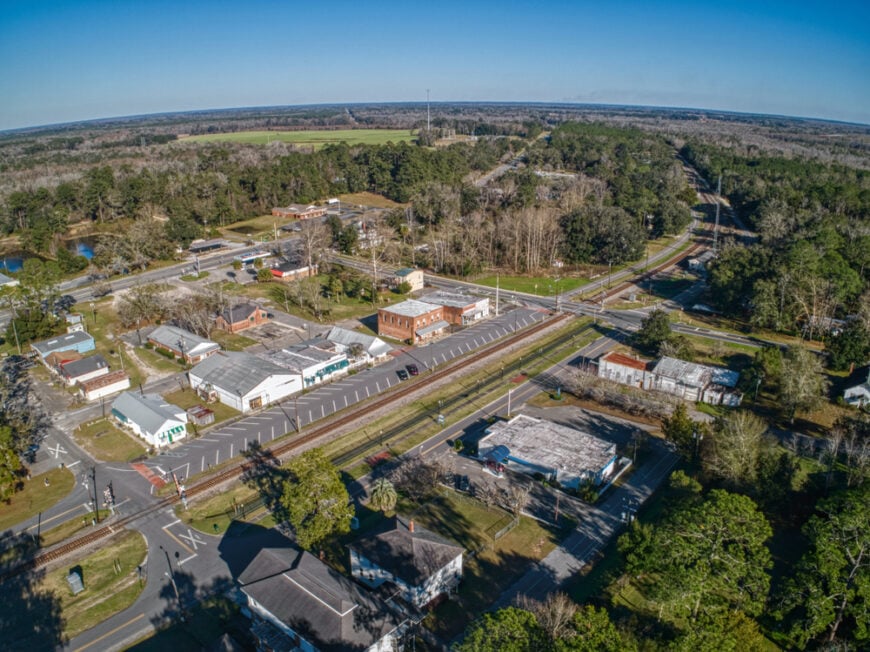
Tucked between pine forests and cypress sloughs, Greenville feels like a secret whispered on the wind. Its population barely brushes 800, but it carries the weight of a hundred-year history etched in hand-hewn cabins and mossy gravestones.
This is a town where life is lived slowly—where the whistle of a distant train replaces traffic and front porches outnumber parking lots. It’s a place to watch deer graze at dusk and lose time beneath towering pines.
With the nearest major highway miles away, Greenville is wrapped in quiet and solitude. Here, seclusion is not an accident—it’s a treasured way of life.
Where is Greenville?
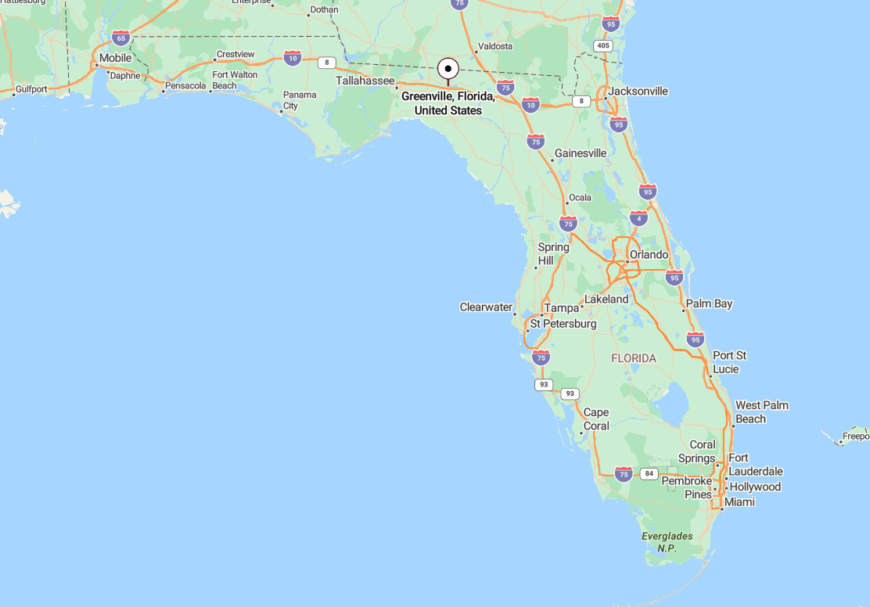
Greenville lies in western Madison County, just south of the Aucilla River and northeast of Perry. The town sits along U.S. 90, but dense forest and marshes shield it from the sprawl of Interstate 10 to the south.
Drivers leave the interstate at a single marked exit, then slip down winding roads flanked by pine thickets and wooden fences. The town appears slowly, like a memory returning.
24. Lee – A Crossroads Town Wrapped in Oaks and Tobacco Fields
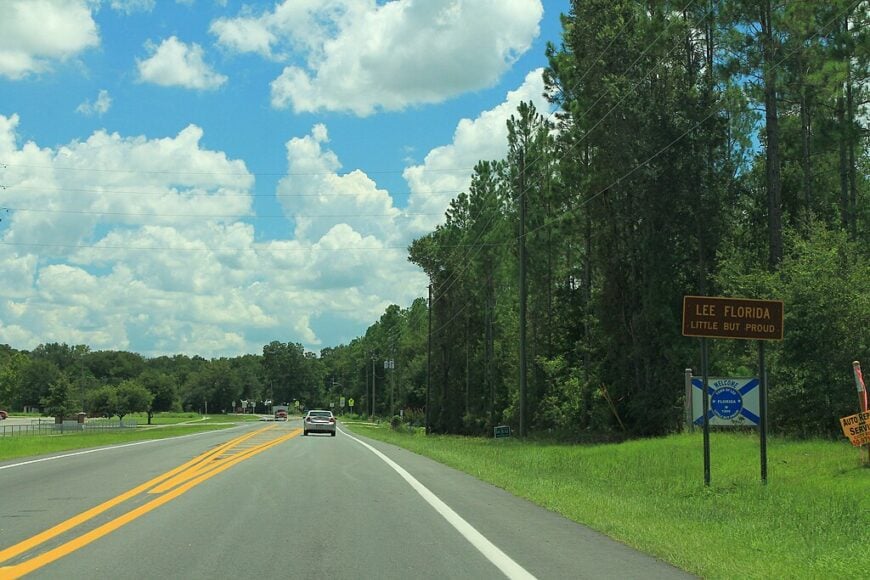
With fewer than 400 residents, Lee is the kind of place where the post office still serves as a gathering spot and the sound of cicadas marks time. Wooden barns, family gardens, and quilted fields of tobacco give the town a faded charm.
Its small size belies its heart: local churches, volunteer fire halls, and homemade signs for peanut boils bring neighbors together. Here, everything you need is within walking distance—if not, you weren’t meant to need it.
Bordered by farmland and the Withlacoochee River, Lee has no strip malls, no rush hour, and no distractions from its rural rhythm.
Where is Lee?
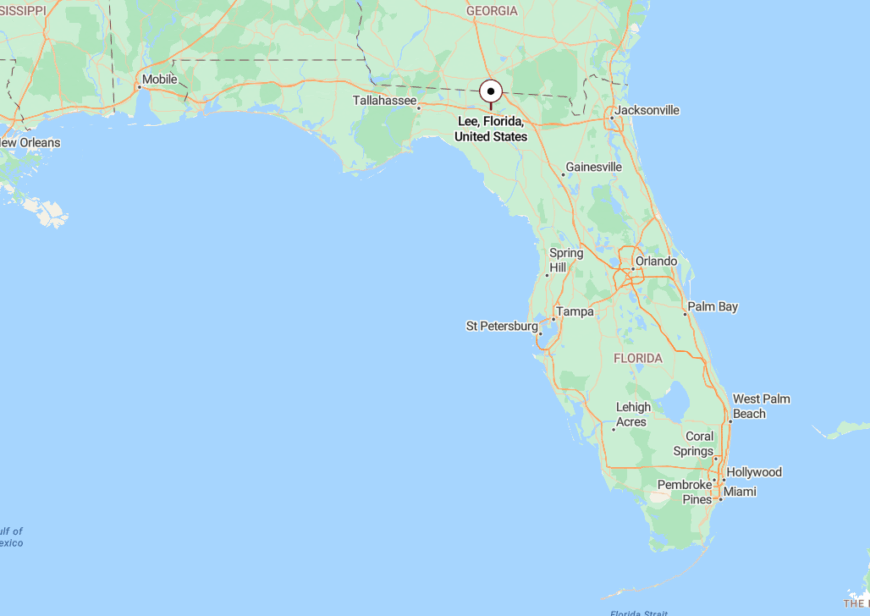
Lee is located in eastern Madison County, just west of the Suwannee County line and near the banks of the Withlacoochee River. Though technically near I-10, the closest access point is a ways off, keeping the town protected from freeway noise.
Travelers typically reach it by U.S. 90 or a series of quiet county roads that weave between soybean fields and cattle pastures. That separation lends Lee its peaceful demeanor.
23. Sanderson – Where Pines and Time Stand Still

A handful of roads and a single blinking light mark Sanderson, where dense pine woods hem in houses and silence feels like a feature. Long a logging town, its pulse is slow but steady—measured in the creak of porch swings and the rustle of palmetto.
Here, mailboxes lean at odd angles, and dirt roads stretch toward nowhere in particular. The surrounding forest is vast enough that wild turkeys often outnumber people on morning walks.
Cut off from tourist trails, Sanderson offers a raw, rooted version of Florida that few passersby get to see.
Where is Sanderson?
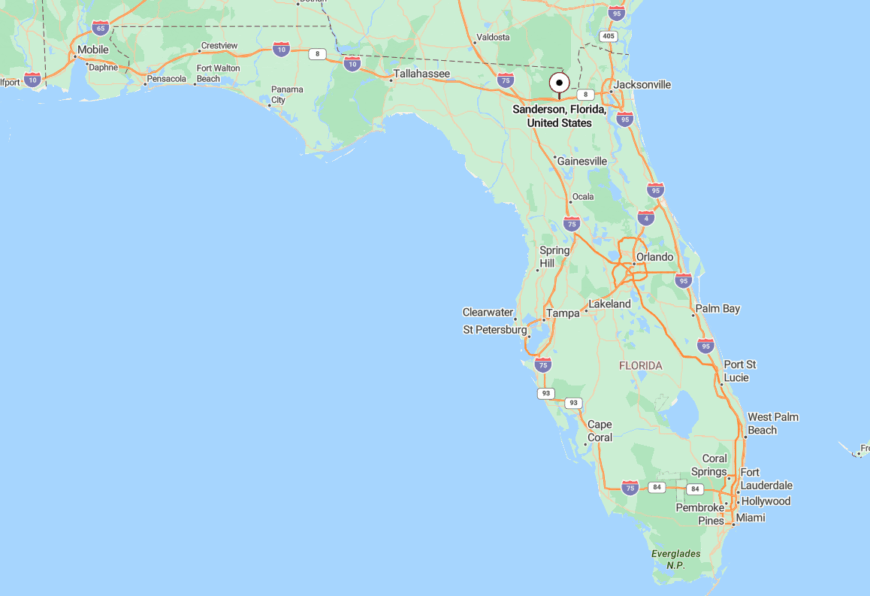
Sanderson sits in central Baker County just off U.S. 90, bordered by pine tracts and the Osceola National Forest. It lies roughly halfway between Lake City and Macclenny.
Though near Interstate 10, its lack of exits and surrounding forestlands make it feel far removed. Cell service flickers, and GPS signals fade—just enough to remind you you’ve wandered somewhere quiet.
22. Wellborn – The Blueberry Capital with a Whisper-Quiet Heart
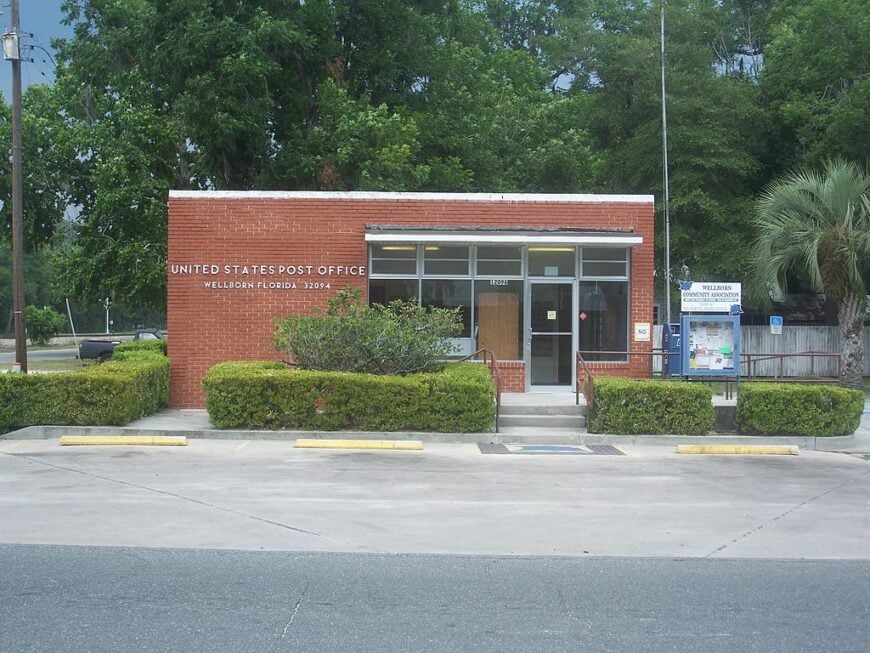
Wellborn may be known for its blueberry festival, but the rest of the year it rests easy in a patchwork of orchards and cattle pastures. With just over 2,500 people scattered across its countryside, the town moves at the pace of its porch rockers.
Pine and pecan trees shade most homes, and an old general store with creaking floors still sells feed and hardware. A single train track divides the town in half, but few trains pass anymore.
Surrounded by timber land and unpaved roads, Wellborn’s quiet isn’t an illusion—it’s the air residents breathe every day.
Where is Wellborn?
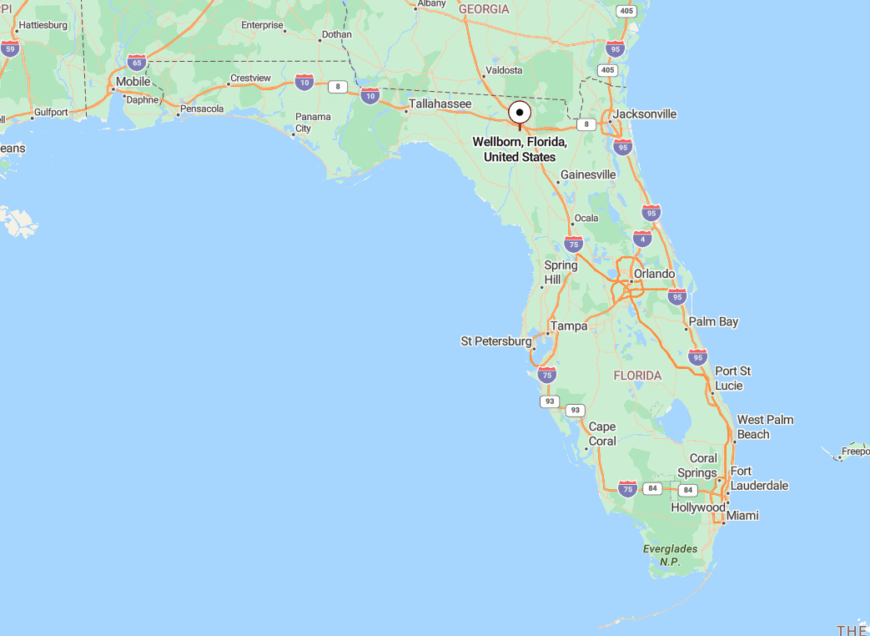
Wellborn is in western Suwannee County, just off U.S. 90 between Live Oak and Lake City. Its position away from major development corridors ensures a rural stillness.
Visitors leave I-10 and follow winding farm roads through stands of pine and low hills. As traffic disappears behind them, the town’s calm presence rises up ahead.
21. Raiford – A Hamlet Known for Silence and Pines
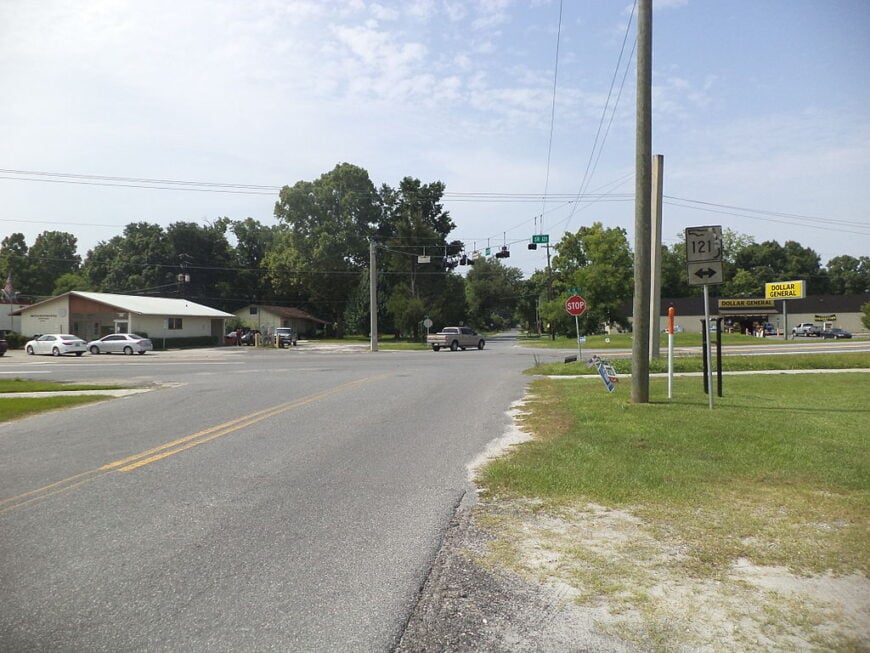
Known to outsiders mostly for its prison, Raiford is more than that—it’s a close-knit community where scrub pines grow thick and two-lane roads curl like ribbon through farmland. Life moves deliberately here, with locals tending goats, raising chickens, and fishing when the weather’s right.
Few towns remain as rooted in place. Raiford’s charm lies not in attractions, but in the absence of them.
Crows, not cars, break the morning stillness, and dirt tracks, not streetlights, guide the way home.
Where is Raiford?
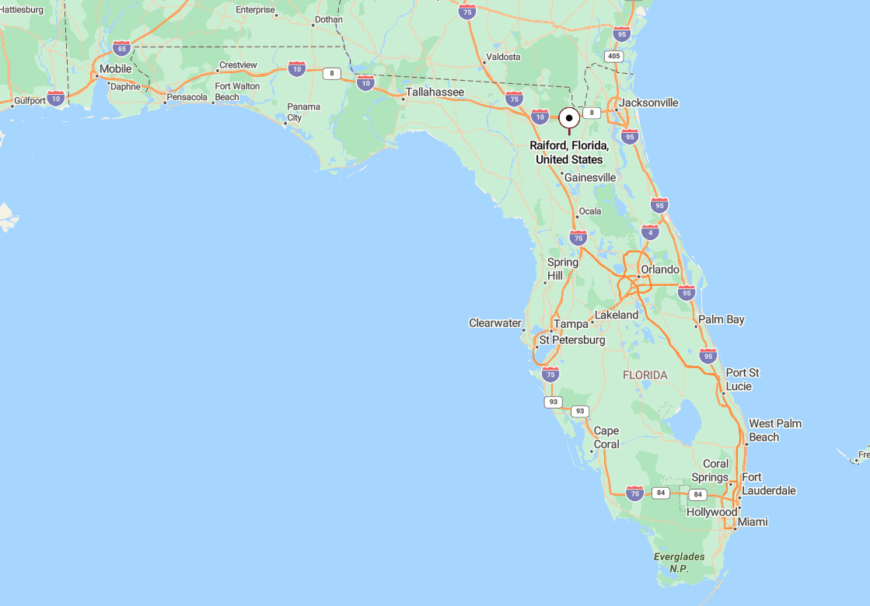
Raiford sits in Union County near the border with Bradford, surrounded by timberland and state forest. It lies northeast of Gainesville and west of Starke, buffered from highways by wide swaths of green.
Travelers typically approach from State Road 121 or local county roads, passing farmland and small bridges over quiet creeks. That slow approach sets the tone for the town itself.
20. Day – The Little Settlement Between Rivers and Pines
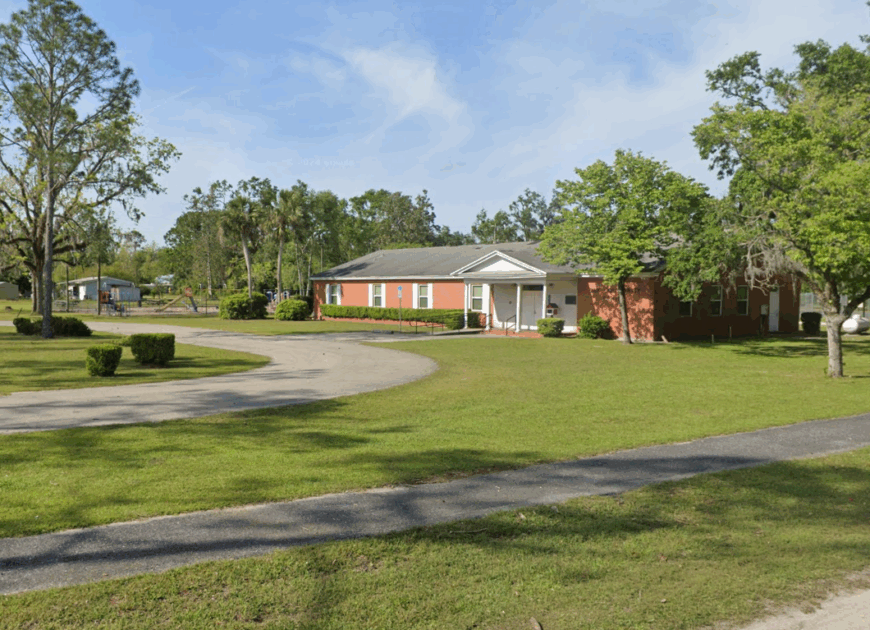
Day lives up to its name—bright, quiet, and fleetingly noticed unless you’re looking. With a population under 200, it’s more settlement than town, built around a crossroads and a smattering of homes hidden behind pine thickets.
Residents often gather at the country church, the community store, or under the oaks where weathered picnic tables offer rest. It’s the kind of place where no one’s a stranger for long.
The absence of any commercial development keeps the skies dark and the nights deeply still.
Where is Day?
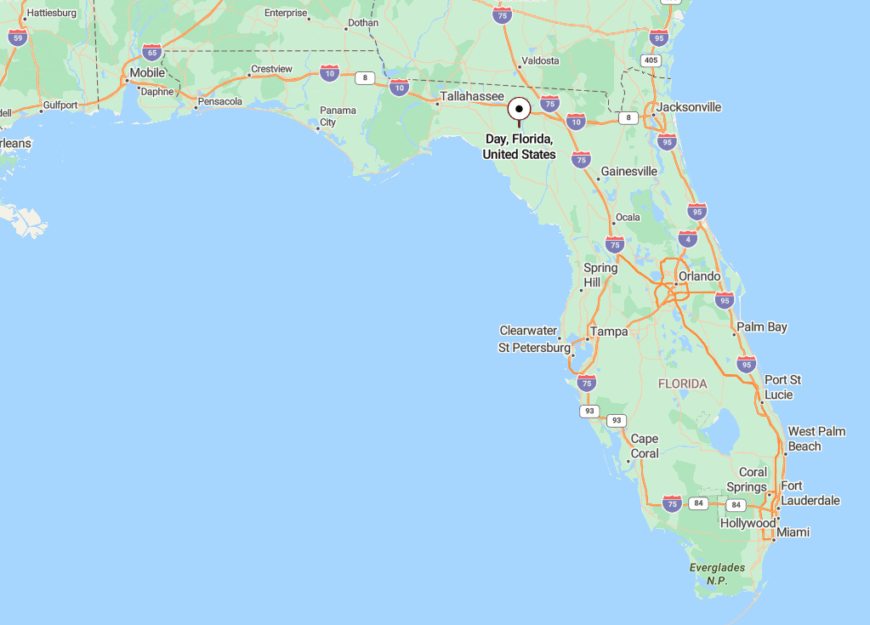
Day rests in Lafayette County along State Road 53, midway between Mayo and Madison. The town is sandwiched between the Suwannee and Aucilla Rivers, both of which help block expansion.
Visitors meander in on quiet two-lane roads that thread through pine plantations and flood-prone lowlands. No highway signs announce the town—you simply arrive.
19. Lulu – A Pocket of Time in Columbia County
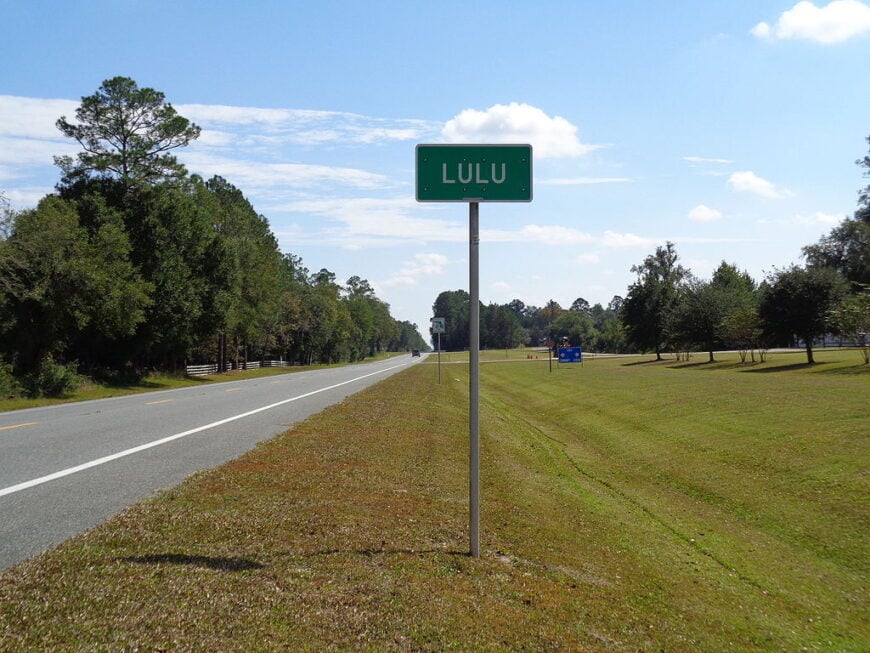
Lulu doesn’t make much noise, and that’s exactly why people stay. Surrounded by pine woods and farmland, this small cluster of homes seems caught in a different era—where dogs roam freely and barns lean with age.
There are no sidewalks, no fast food, and no stoplights. Instead, life here is marked by sunrise chores, cool evenings, and stars bright enough to cast shadows.
Neighbors know each other by name, and the closest grocery run can take half an hour each way—an inconvenience that protects the town’s peace.
Where is Lulu?
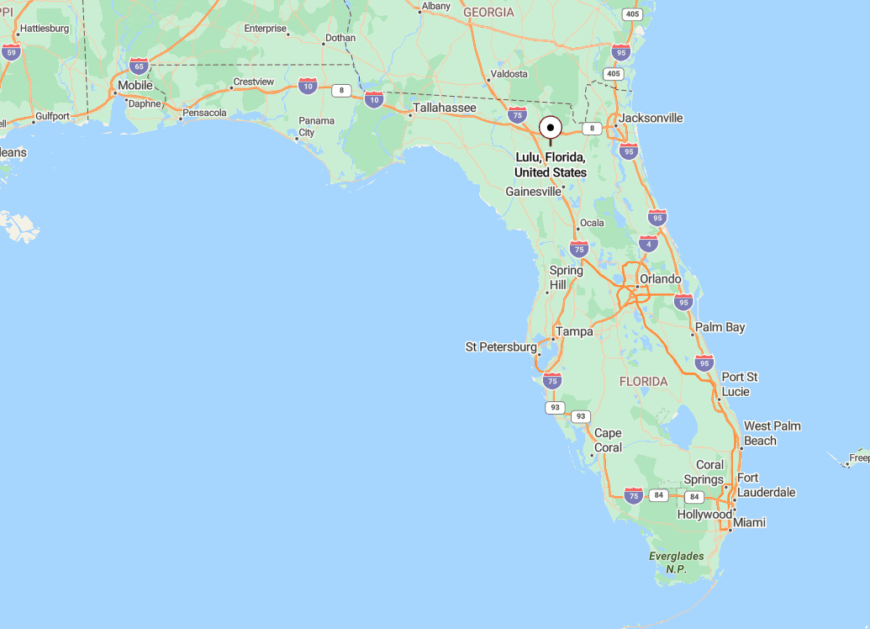
Lulu is located in southern Columbia County, not far from the Alachua County line. It sits south of Lake City, down a mix of paved and unpaved roads with names like Tustenuggee.
The town’s remoteness stems from its lack of major road access and its dense forest borders. It feels tucked away, both in distance and in spirit.
18. Island Grove – Where Citrus Trees Meet Still Waters
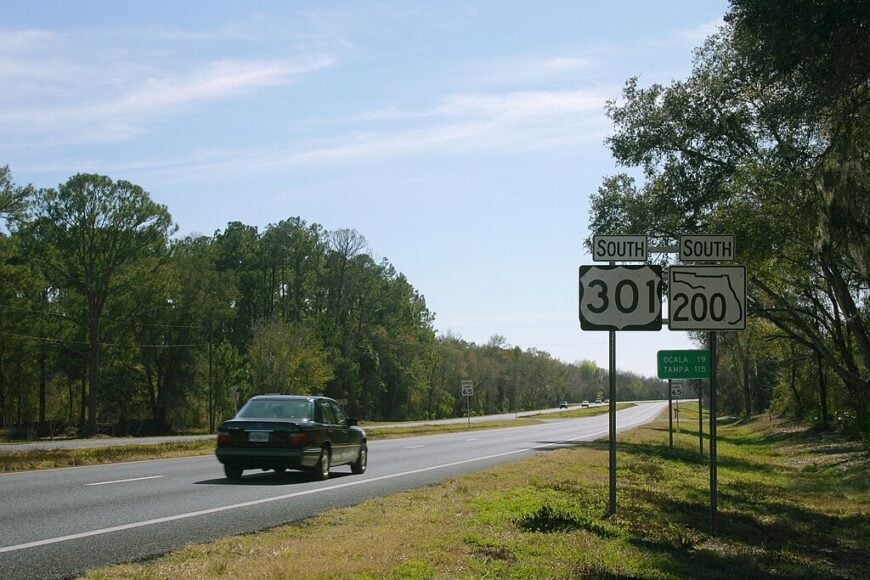
Island Grove is a quiet bend in the road, where wild orange groves and sawgrass flats stretch wide. Home to fewer than 300 residents, the town traces its roots to old citrus routes and forgotten train stops.
Porches sag beneath the weight of time, and the narrow roads carry more bicycles than trucks. It’s a place where egrets outnumber tourists and no one seems to be in a hurry.
The surrounding wetlands and the edge of Orange Lake act like natural walls, keeping the modern world at bay.
Where is Island Grove?
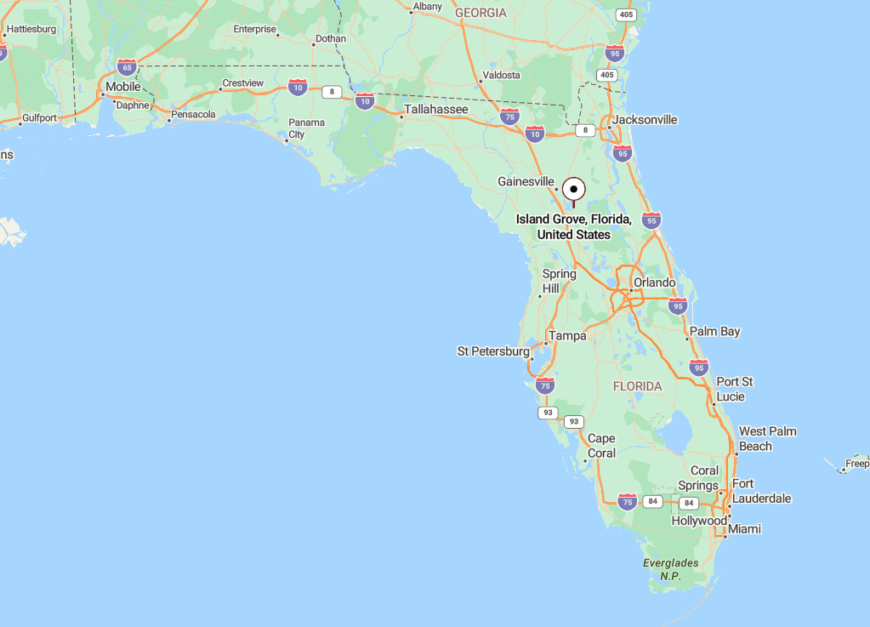
Island Grove is in southeastern Alachua County, at the edge of Orange Lake near the Marion County border. It’s reachable by County Road 325, a quiet road that curves through marsh and field.
The town’s watery borders and protected wetlands discourage any new construction, preserving its serene stillness.
17. Cross City – A Junction Town with a Wild Edge
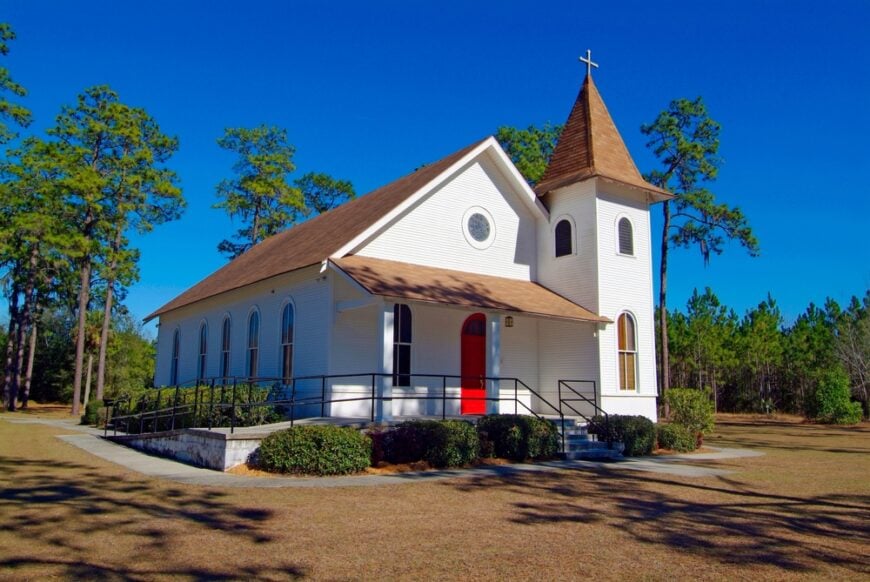
Despite its name, Cross City is more wide space than city—built around a few major intersections but ringed by forest and swamp. Its downtown is modest, its pace deliberate, and its charm lies in its rough-edged authenticity.
Locals fish the Steinhatchee River, hunt in nearby management areas, and tell stories over diner breakfasts that stretch into lunch.
Though it’s technically a hub for surrounding wilderness, Cross City never feels crowded, thanks to its sprawl of green and low population density.
Where is Cross City?

Cross City lies in central Dixie County, roughly 15 miles inland from the Gulf Coast. It sits along U.S. 19, but the town spreads slowly in every direction, with forest and wetlands hemming it in.
Though accessible by car, the town’s vast surrounding wildlands grant it a sense of solitude uncommon for a county seat.
16. Grand Ridge – A Quiet Rise in Jackson County
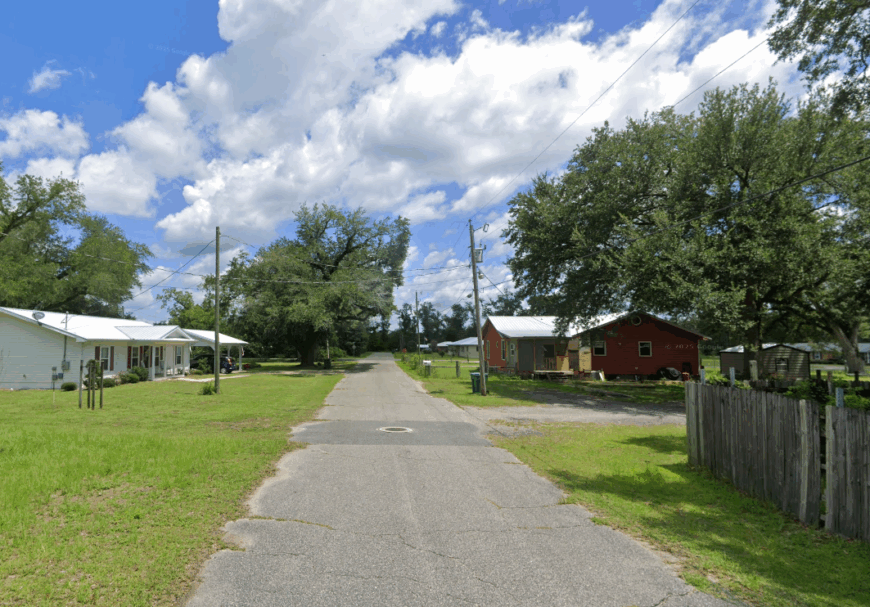
Perched on a small ridge above the Apalachicola River floodplain, Grand Ridge feels like a highland refuge in the flat panhandle. With fewer than 1,000 residents and large lots scattered across hills, the town keeps its distance by design.
Daily life moves from porches to pecan orchards to farm stands, and the sound of tires on gravel is often the loudest interruption.
The surrounding pine forests and lack of large employers mean that few pass through unless they mean to.
Where is Grand Ridge?
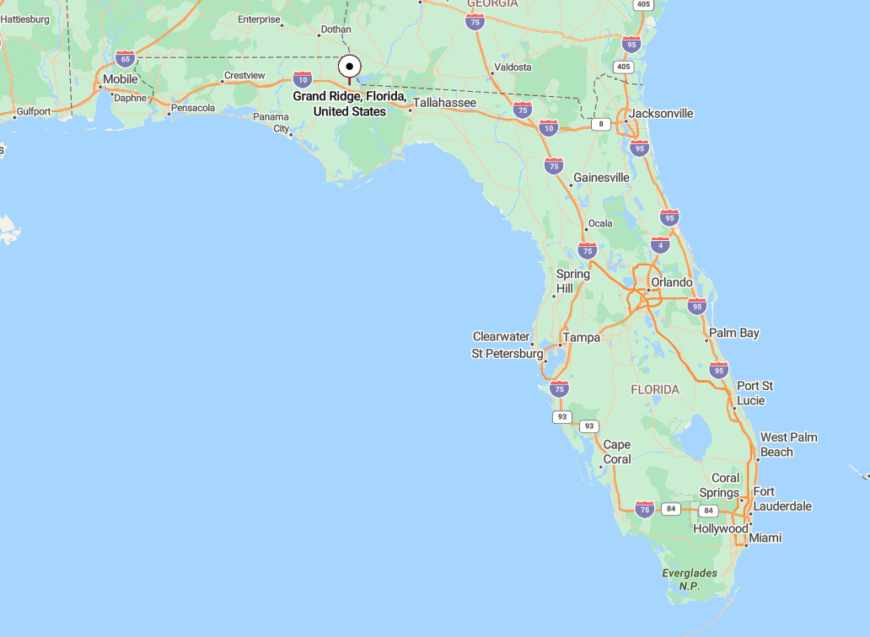
Grand Ridge is in eastern Jackson County, just south of Interstate 10 but far enough from any exits to remain quiet. It sits north of the Chipola River and west of the Apalachicola basin.
The town is reached via State Road 69, which winds through farmland and low hills. That slight elevation gives it both views and insulation.
15. Altha – A Hilltop Settlement in the Wiregrass Fringe
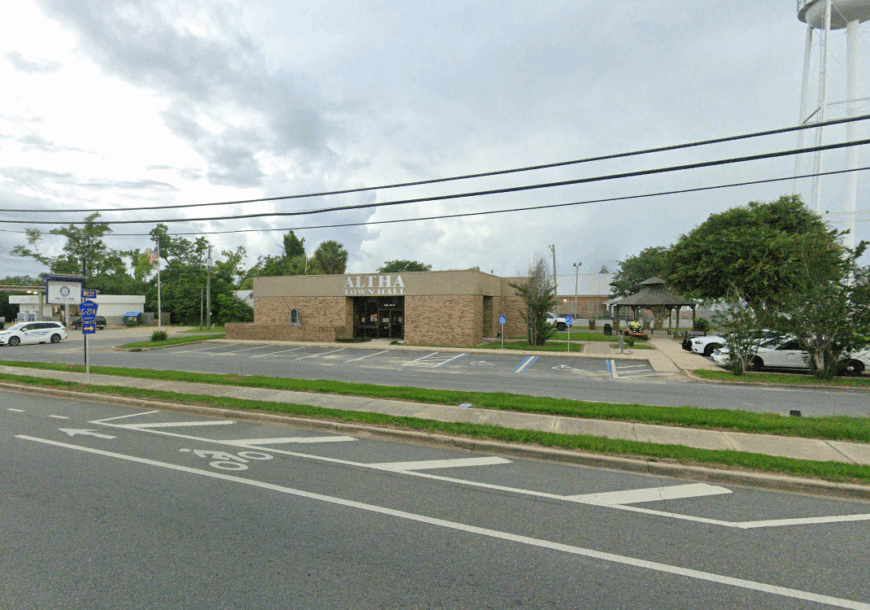
Altha is a small Calhoun County community of around 500, where clay roads, peanut fields, and red barns define the view. It rests on gentle uplands that roll south toward the Gulf, giving the town a sense of height and space.
Locals spend days working the land or gathering at the school gym, one of the town’s few public hubs. Nights are quiet enough to hear coyotes calling from far tree lines.
Ringed by forest and farmland, Altha stands apart as a self-contained pocket of rural life.
Where is Altha?
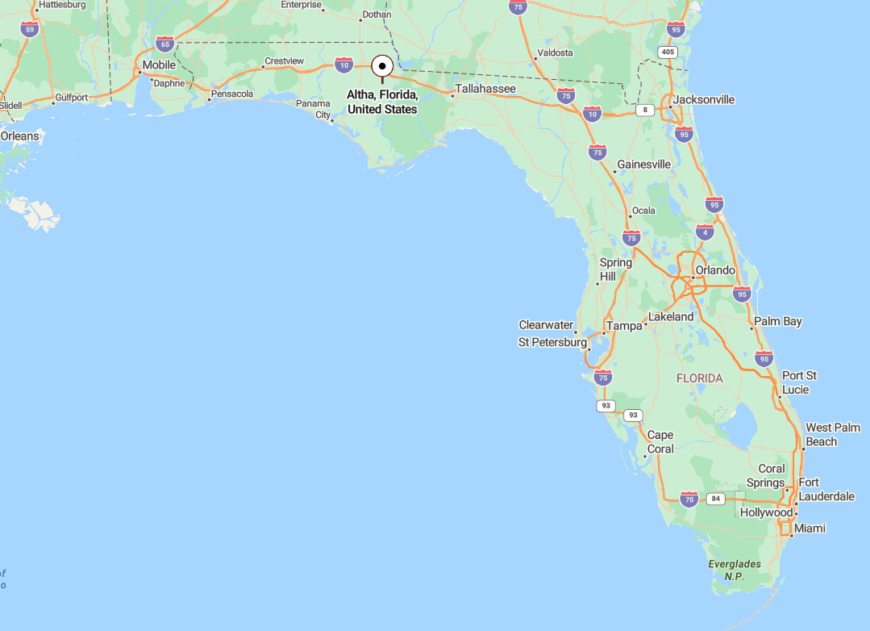
Altha is in western Calhoun County, about 25 miles south of Marianna and 15 miles north of Blountstown. It’s accessible by State Road 71, but most other roads into town are rural routes flanked by farms.
Its location on a ridge, combined with low traffic and a surrounding greenbelt, ensures Altha stays peaceful.
14. Greensboro – Panhandle Seclusion with Tobacco Roots
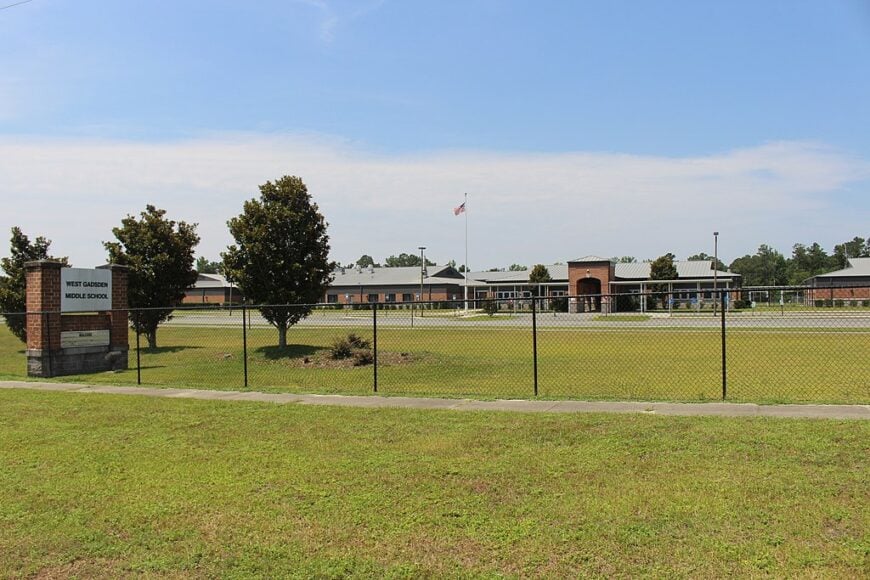
Greensboro once thrived on tobacco farming, and though those days have passed, the old barns and rolling fields remain. With under 600 residents, the town feels like a place time politely overlooked.
Oak-lined streets, weathered houses, and quiet storefronts give Greensboro an old-soul charm. Locals know every trail, every shortcut, and every storm cloud.
Its isolation is helped by its position between larger towns, making it easy to miss unless you’re seeking it.
Where is Greensboro?
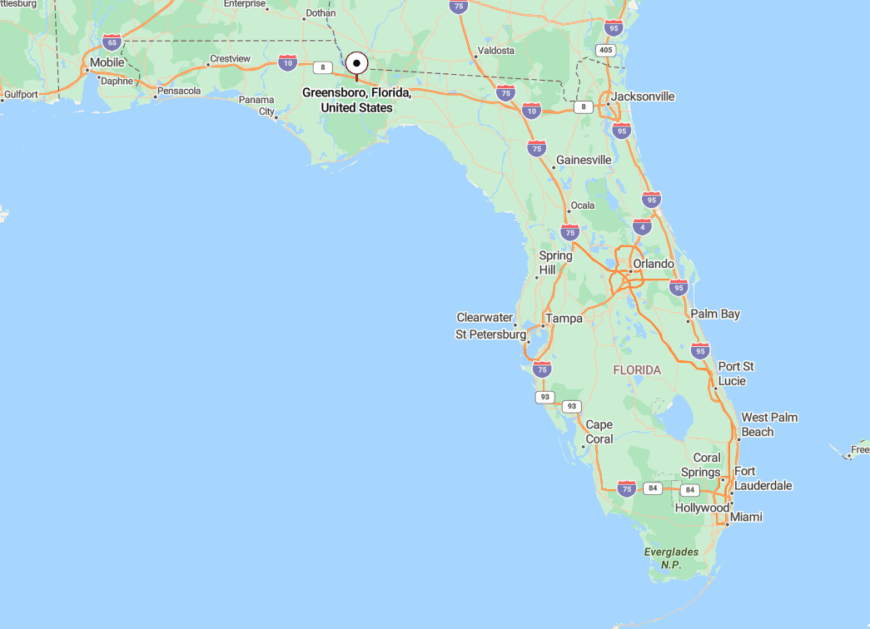
Greensboro is located in Gadsden County, west of Quincy and south of Chattahoochee. The town is accessible by State Road 12, a scenic route through farmland and pine woods.
It’s surrounded by swaths of timberland and a sparse road network, which helps preserve its small-town stillness.
13. Sumatra – Where the Apalachicola Forest Breathes
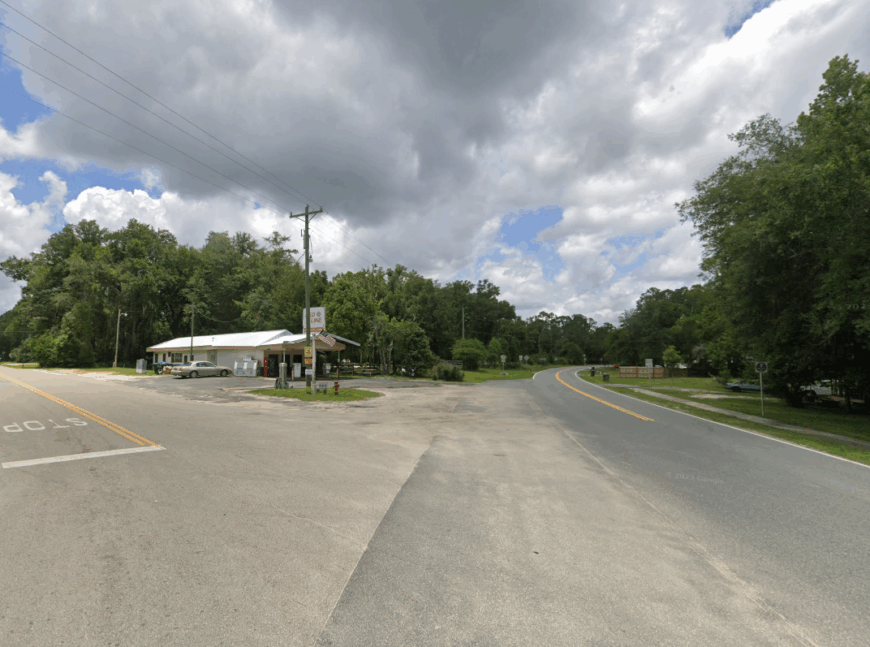
With fewer than 200 people and surrounded on all sides by national forest, Sumatra might be Florida’s most hidden village. Longleaf pines line every road, and gopher tortoises outnumber porch lights.
Locals fish the Apalachicola River, hunt deep in the forest, and gather at the lone country store like it’s a town square.
There are no subdivisions, no noise, and no hurry—just forest and time.
Where is Sumatra?
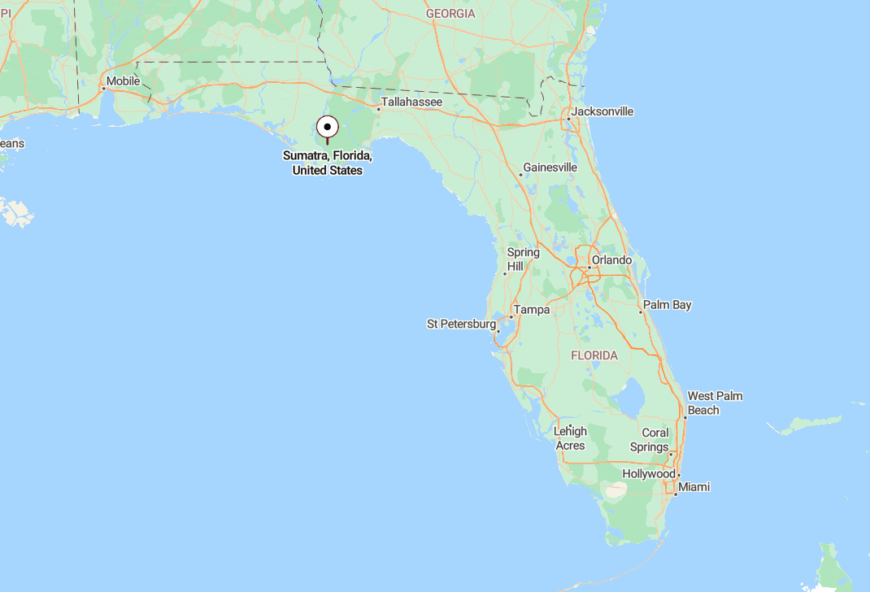
Sumatra sits in southwestern Liberty County, surrounded by the Apalachicola National Forest. It lies along State Road 65, a quiet highway that connects small Panhandle towns.
The nearest grocery store is miles away, and the forest acts as a natural boundary in every direction. It’s a place you drive to on purpose—or never at all.
12. Wausau – Home of Possum Day and Pinewood Solitude
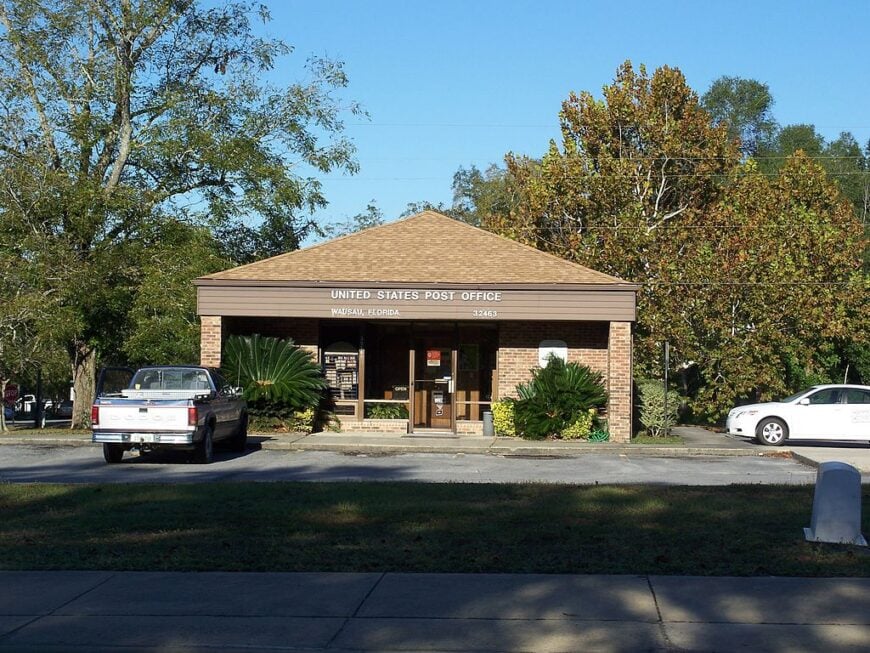
Wausau is best known for its annual Possum Festival, but the rest of the year it’s a sleepy pine-shaded town of 400 or so. The air smells of pine sap and the hum of crickets rarely stops.
Porch swings creak in the afternoons, and the local hardware store doubles as a social hub. In Wausau, the world shrinks to what matters most—neighbors, weather, and what’s for dinner.
Seclusion comes easy here thanks to slow roads, tall trees, and the absence of anything faster than a tractor.
Where is Wausau?
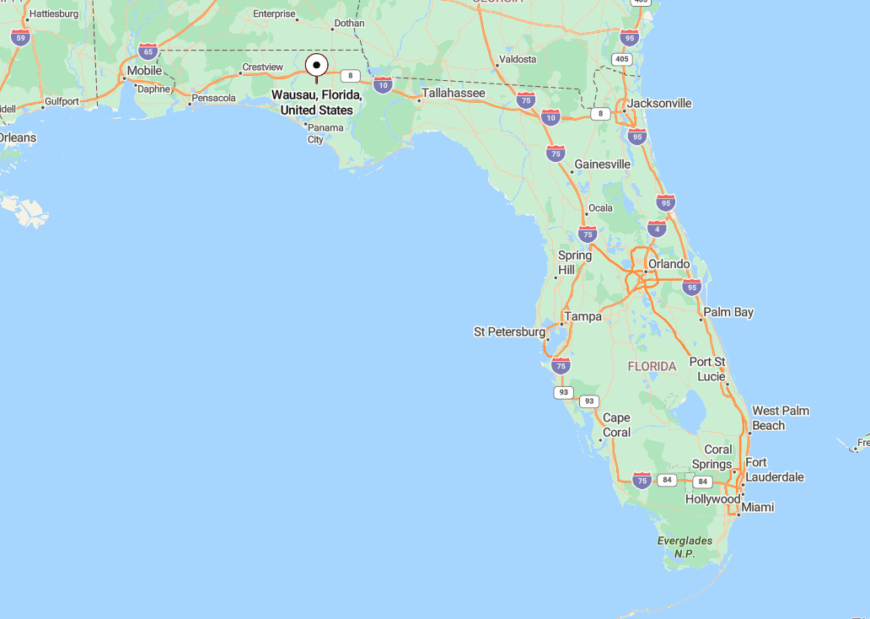
Wausau is in Washington County, west of Chipley and north of Vernon. It’s reachable by State Road 77, though most visitors come on smaller county routes.
Forests, farms, and narrow rivers form natural barriers, granting Wausau its peaceful reputation.
11. Pinetta – A Borderline Beauty with Fewer Than 200 Souls
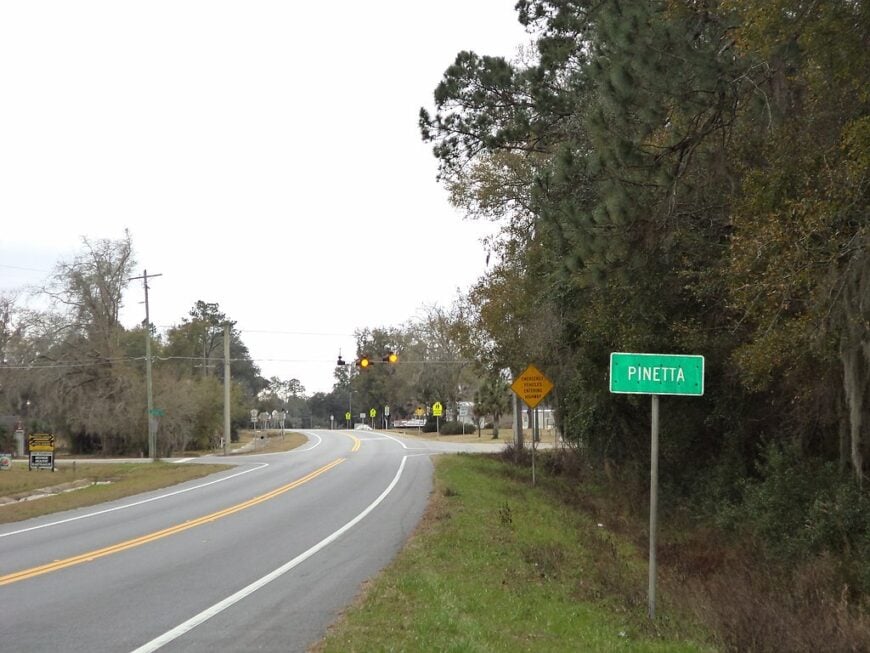
Pinetta sits like a whisper at Florida’s northern edge, where Georgia feels just a stone’s throw away. Its homes cluster around a modest post office, a church or two, and fields that glow gold at sunset.
Most people here work the land or commute to Madison, though some still barter eggs for services in true old-fashioned style. Life feels spacious, quiet, and just a bit enchanted.
Surrounded by farmland and stitched together by dirt roads, Pinetta is as removed as it is rooted.
Where is Pinetta?
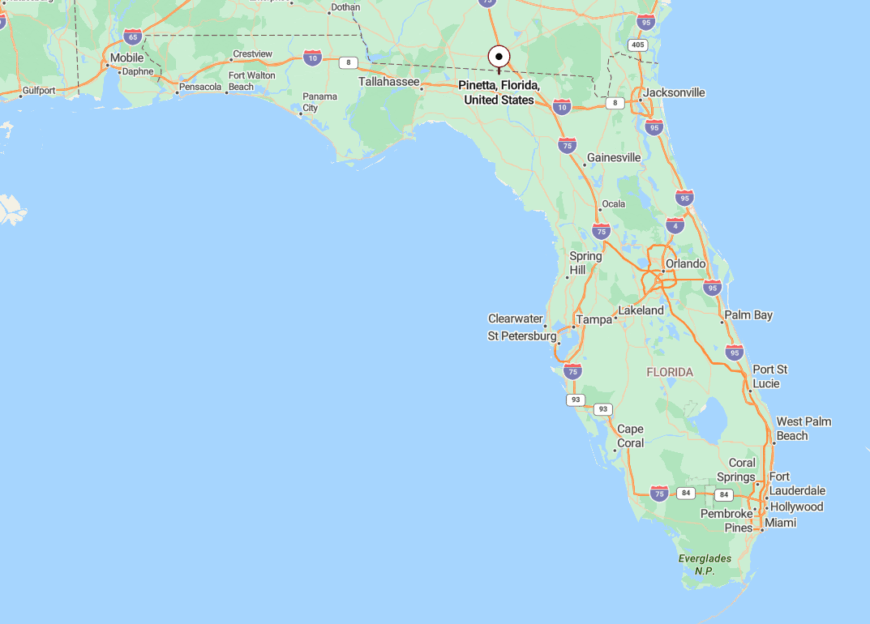
Pinetta is in northern Madison County, just below the Georgia line. It’s accessed by State Road 145, though the last stretch narrows beneath oaks and fencerows.
The town’s proximity to the state border and its sparse surroundings make it feel like the edge of something old and timeless.
10. Sopchoppy – A Tiny River Hamlet Guarded by Apalachicola National Forest
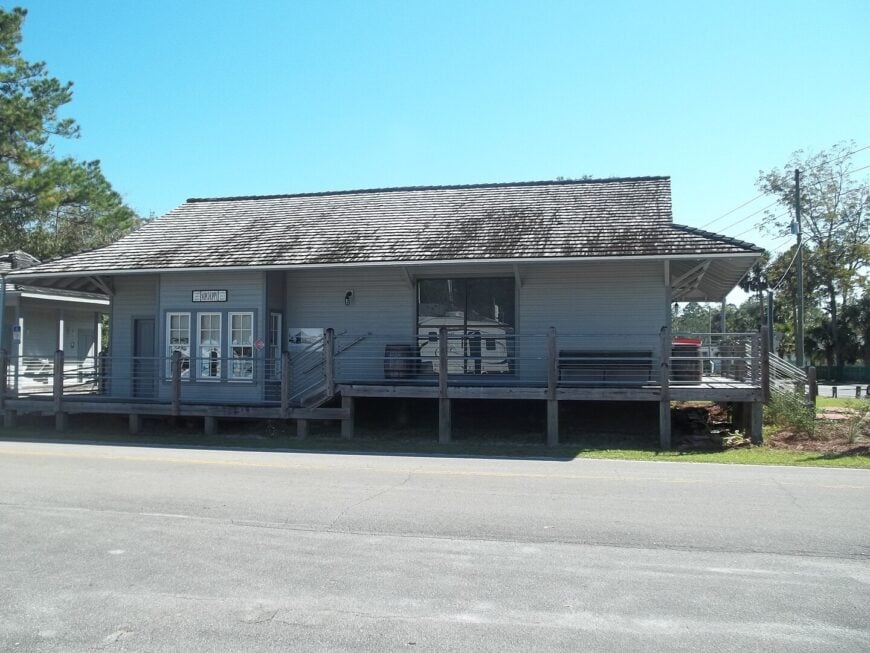
Roughly 450 people call Sopchoppy home, and many of them gather each April for the eccentric Worm Gruntin’ Festival that celebrates a bygone bait-harvesting skill. Canoeing the sinuous Sopchoppy River, hiking the Florida National Scenic Trail, and birding in nearby Ochlockonee River State Park give weekend explorers plenty to do.
Small-scale forestry, oyster harvesting out of neighboring Panacea, and a modest trickle of eco-tourism anchor the local economy. Downtown amounts to a brick depot, a vintage café, and a historic city hall, all sitting beneath cathedral-tall longleaf pines.
The surrounding Apalachicola National Forest acts like a living moat, cutting road access to just a couple of routes and keeping light pollution at near-zero. That green buffer, plus a 45-minute drive to Tallahassee, ensures Sopchoppy retains its deeply secluded feel.
Where is Sopchoppy?
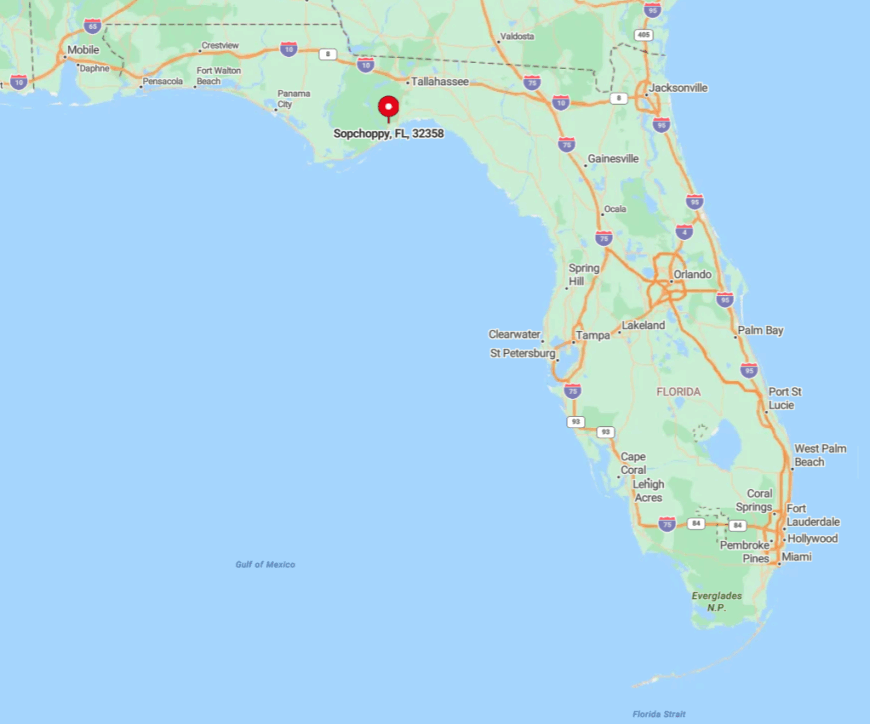
Sopchoppy rests in southern Wakulla County, nine miles inland from the Gulf of Mexico and smack in the center of Florida’s largest national forest. The pine barrens and palmetto flats that surround it swallow noise and development alike, making the town feel far farther from the capital than the mileage suggests.
Drivers reach it via State Road 319 or the narrower County Road 375, both of which slice through miles of federally protected land. Cell service flickers en route, a subtle hint that you have indeed slipped off the grid.
9. Wacissa – Spring-Fed Seclusion in Jefferson County
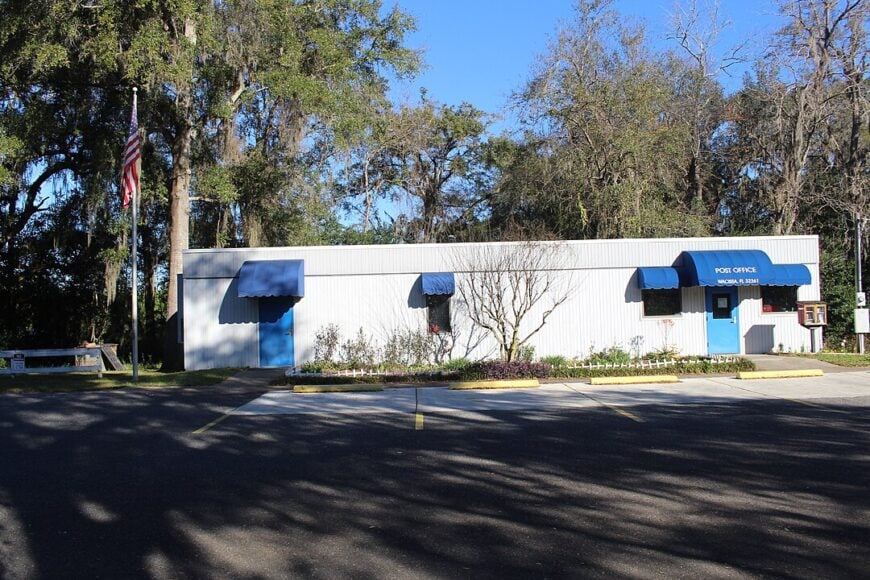
Fewer than 300 residents live along the cypress-fringed bends of the Wacissa River, a short waterway kept crystal-clear by more than a dozen first-magnitude springs. Locals spend weekends paddling to Blue Springs or sink-snorkeling at Big Blue Hole, where limestone walls drop 90 feet.
Aside from a seasonal outfitter and a tiny convenience store, economic life centers on cattle ranching and a smattering of organic farms that benefit from the river’s nutrient-rich floodplain. No commercial strip, no stoplight, and no through-traffic contribute to the town’s whisper-quiet character.
Miles of hardwood hammocks and the conserved headwaters of the Aucilla River form a natural barrier to sprawl. The combination of watery wilderness and a twenty-mile drive to Tallahassee keeps Wacissa delightfully tucked away.
Where is Wacissa?
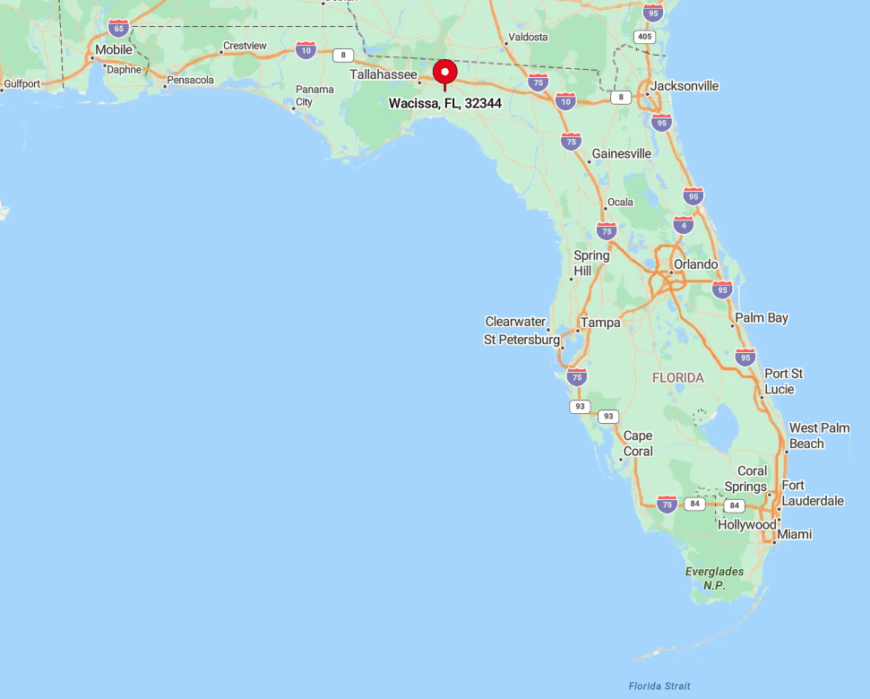
Wacissa sits in southern Jefferson County, roughly equidistant from the Gulf Coast and Florida’s capital. The lack of major highways—only County Road 259 feeds the settlement—helps preserve its remoteness.
Visitors generally exit U.S. 19 at Lamont, then meander through ranchland before the asphalt narrows under arching live oaks. Canoes strapped to roof racks are a common clue you are on the right road.
8. McAlpin – Suwannee County’s Oak-Shaded Hideaway
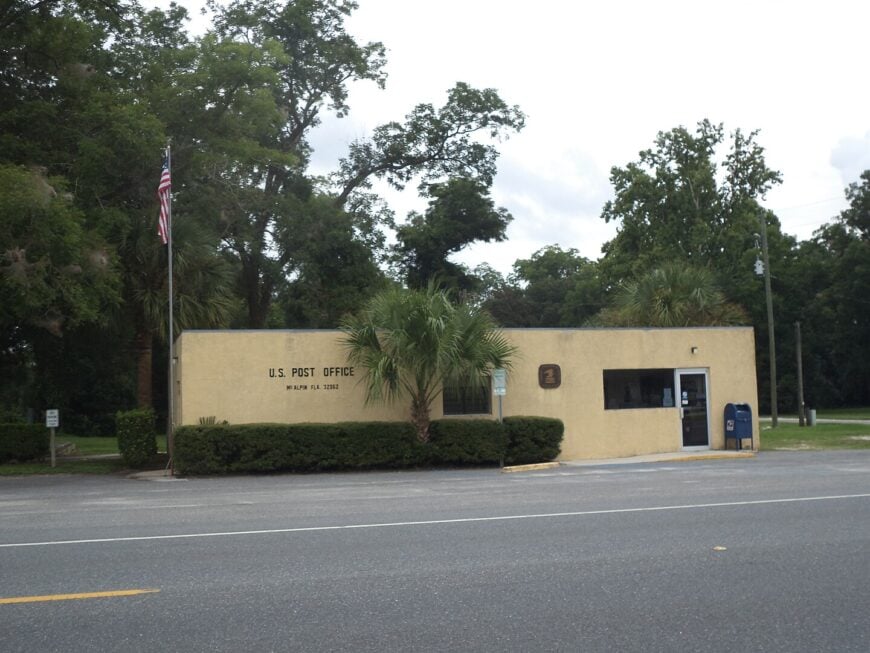
This unincorporated community numbers just under 600 people, most living on farmsteads hidden by majestic live-oak canopies. Days revolve around tending cattle, baling hay, and driving produce to the Saturday market in nearby Live Oak.
Horseback rides down sand lanes, fishing at Peacock Slough, and exploring the lesser-known Charles Springs on the Suwannee River fill leisure hours. Agriculture and timber provide the lion’s share of income, supplemented by a small but growing network of home-based telecommuters who prize the quiet.
With parcels often measured in tens of acres and no streetlights to compete with the stars, McAlpin feels far from modern bustle. The nearest big-box store sits fifteen miles away, reinforcing the village’s secluded reputation.
Where is McAlpin?

McAlpin lies roughly halfway between Live Oak and Branford along U.S. 129 in southern Suwannee County. The Suwannee River bends west of town, while vast pine plantations shoulder the eastern horizon, hemming the settlement in green.
Travelers leave Interstate 10 at Exit 283 and follow farm roads south for twenty minutes before oaks crowd overhead and cell reception dips. A hand-painted sign by the volunteer fire station lets newcomers know they have arrived.
7. Micanopy – Florida’s Oldest Inland Village Wrapped in Moss and Mystery
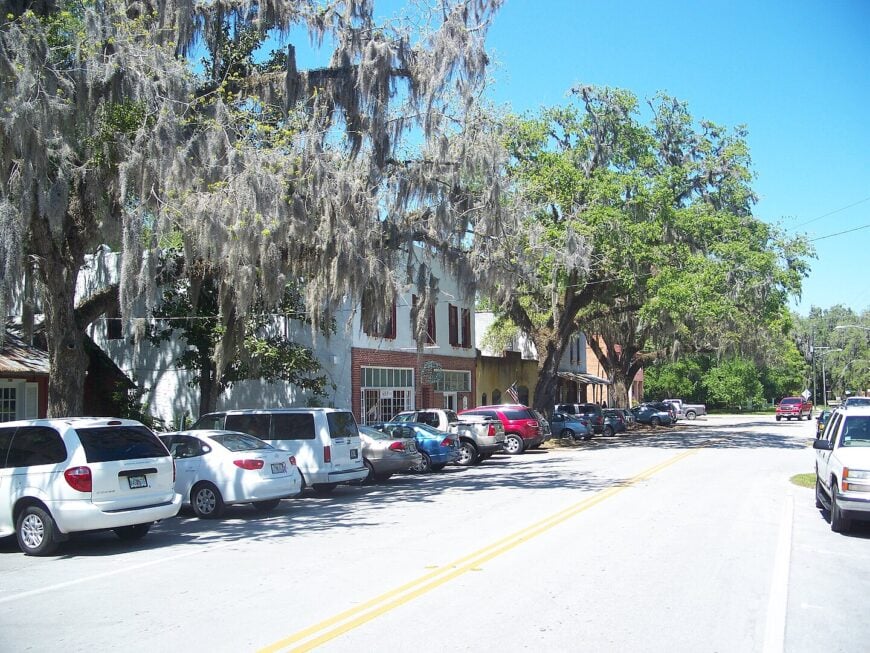
About 600 residents share this storybook enclave where century-old cracker cottages peek from behind Spanish-moss curtains. Antique shops line Cholokka Boulevard, and Saturday art fairs spill onto brick sidewalks, yet evenings seldom rise above a hush broken by tree frogs.
Tourism, small-batch pecan farming, and the University of Florida research plots on the town’s edge form the main economic pillars. Paynes Prairie Preserve State Park clamps Micanopy to the north, east, and west, while Tuscawilla Lake forms a watery barricade to the south.
Those natural buffers muffle highway noise and halt suburban creep from Gainesville. As a result, residents enjoy a secluded vibe despite living only fifteen minutes from a major university town.
Where is Micanopy?
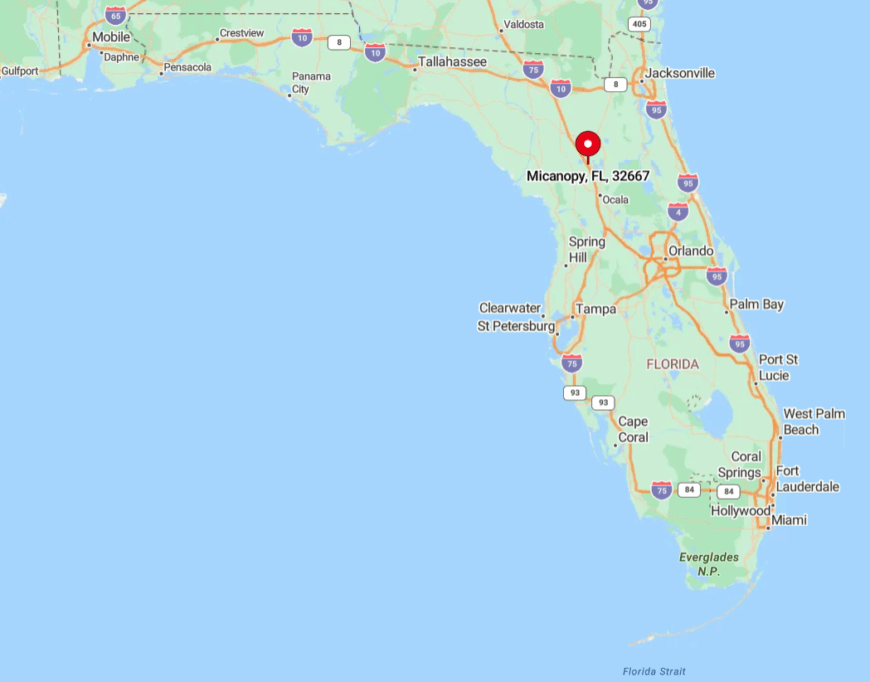
Positioned just off U.S. 441 in southern Alachua County, Micanopy occupies a low ridge overlooking the vast prairie. Dense sawgrass marsh and flood-prone savanna surrounding the ridge thwart large-scale development.
Drivers typically exit Interstate 75 at Micanopy Road, then wind beneath oaks that lean so close their limbs form a tunnel. Limited parking and narrow lanes slow traffic to walking pace, preserving the village’s unhurried air.
6. Bell – Gilchrist County’s One-Stoplight Sanctuary
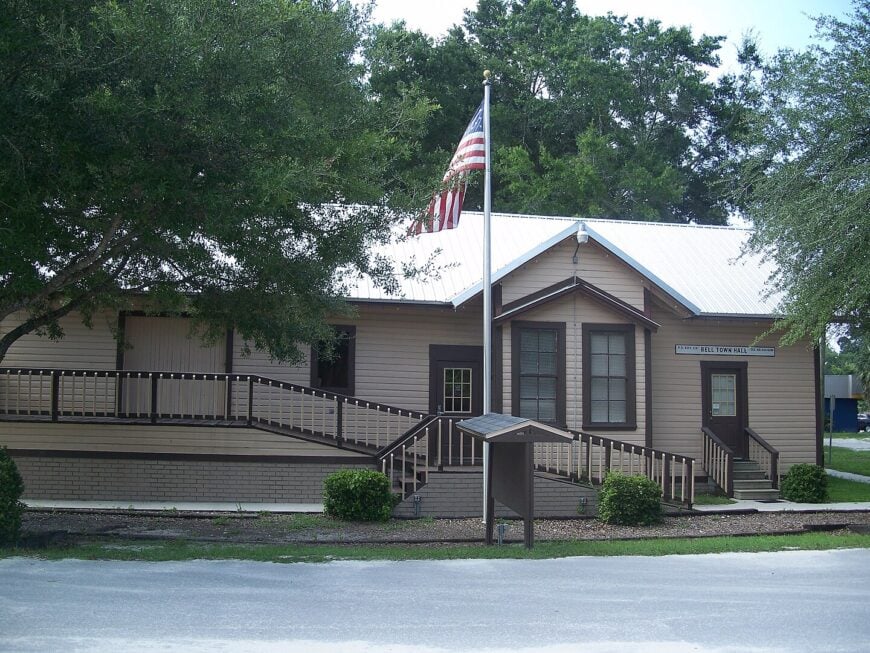
Bell’s population hovers near 500, and the single traffic signal blinks red more often than it turns green. Residents kayak the tannin-stained Suwannee, picnic under the century-old oaks at Hart Springs, or bike the Nature Coast State Trail that bisects town.
Cattle ranching, peanut farming, and a tidy cluster of mom-and-pop stores on Main Street sustain local wallets. Beyond a mile-long downtown, fields roll toward river bluffs that shelter Bell from tourist corridors farther south.
Limited cell coverage west of town and vast tracts of private timberland eastward add layers of privacy. Visitors quickly notice that after sunset, the loudest sound is usually a whip-poor-will.
Where is Bell?
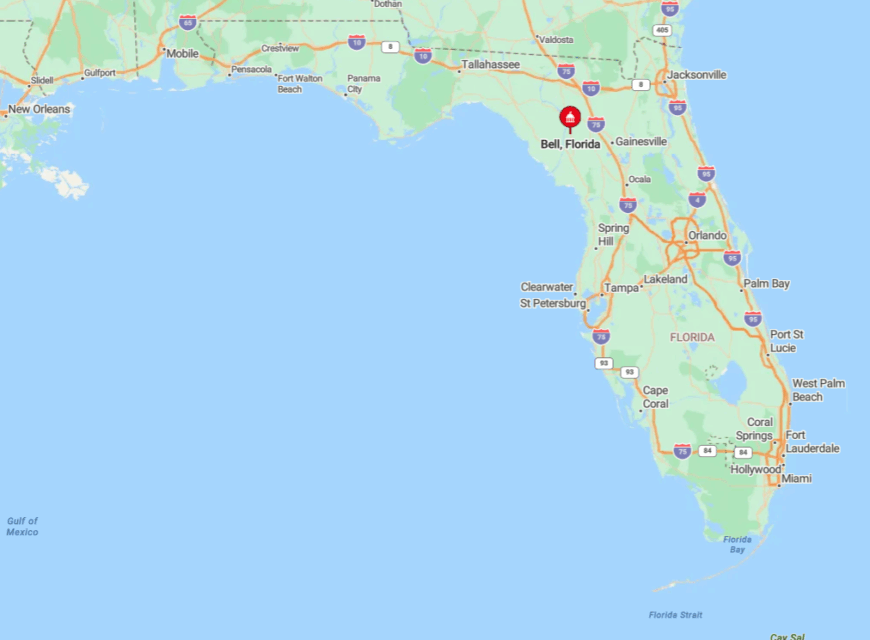
The town sits in northern Gilchrist County, six miles east of the Suwannee River and twenty minutes north of Fanning Springs. With no interstate nearby, drivers rely on County Road 340 or State Road 129 to reach it, both lightly traveled ribbons through farmland.
The river’s high limestone banks and surrounding conservation easements block expansion from the west, while sparsely populated Trenton serves as the nearest service hub to the south. That geographic isolation keeps Bell’s skyline dominated by grain silos, not billboards.
5. Olustee – Pine-Forest Pocket Beside the National Battlefield
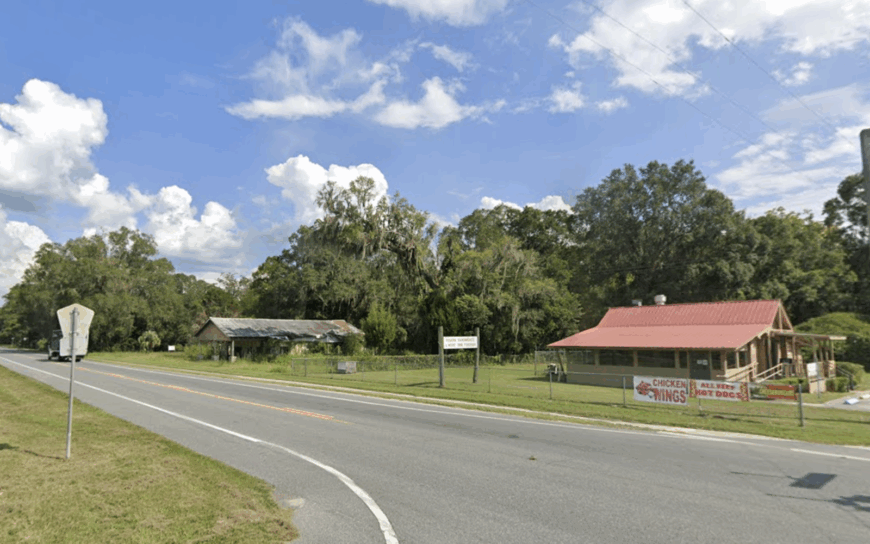
Olustee claims roughly 300 inhabitants, most living on sandy lanes speckled with wiregrass and longleaf pines. History buffs visit the Olustee Battlefield Historic State Park each February for a Civil War reenactment, while locals hike the nearby Florida Trail or fish small tannic ponds hidden in the forest.
Forestry, government land management, and seasonal heritage tourism make up the modest economic mix. Ringed on three sides by Osceola National Forest and buffered by protected wetlands to the south, the settlement sits like an island within a sea of trees.
With Jacksonville’s suburbs over thirty miles away and no gas station in town, night skies stay ink-black and traffic limited to logging trucks. That woodland buffer cements Olustee’s reputation as one of North Florida’s best-kept secrets.
Where is Olustee?
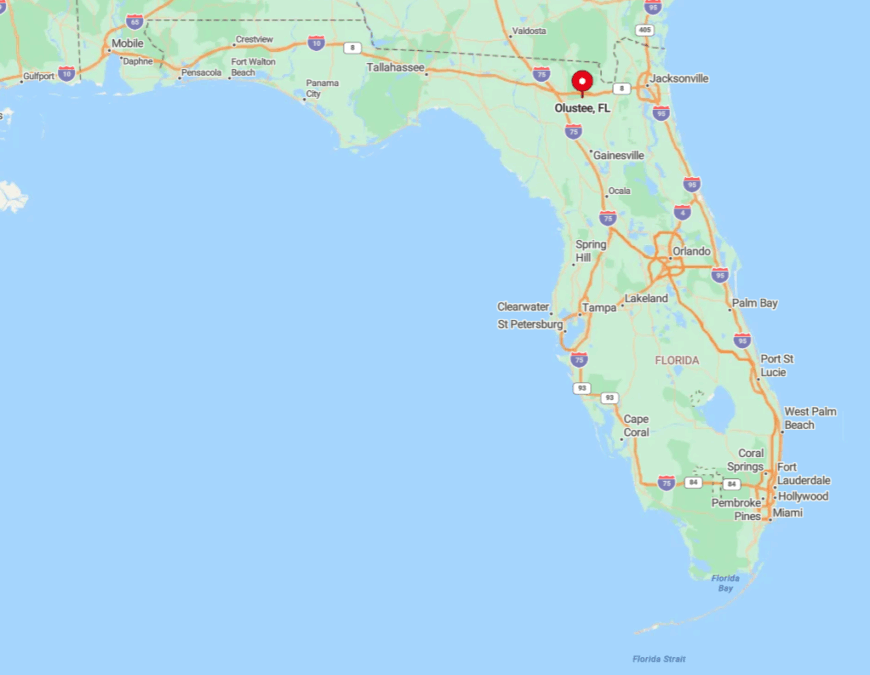
Olustee occupies the western edge of Baker County just off U.S. 90, ten miles west of Lake City’s commuter belt. Osceola National Forest engulfs the area, limiting development corridors and creating natural firebreaks that double as wildlife viewing lanes.
Visitors generally exit Interstate 10 at the small Olustee sign, then glide five miles through pine-needle-covered shoulders before seeing the brick depot museum. No public transit reaches the hamlet, so private vehicle remains the only way in or out.
4. Brooker – Bradford County’s Two-Road Retreat
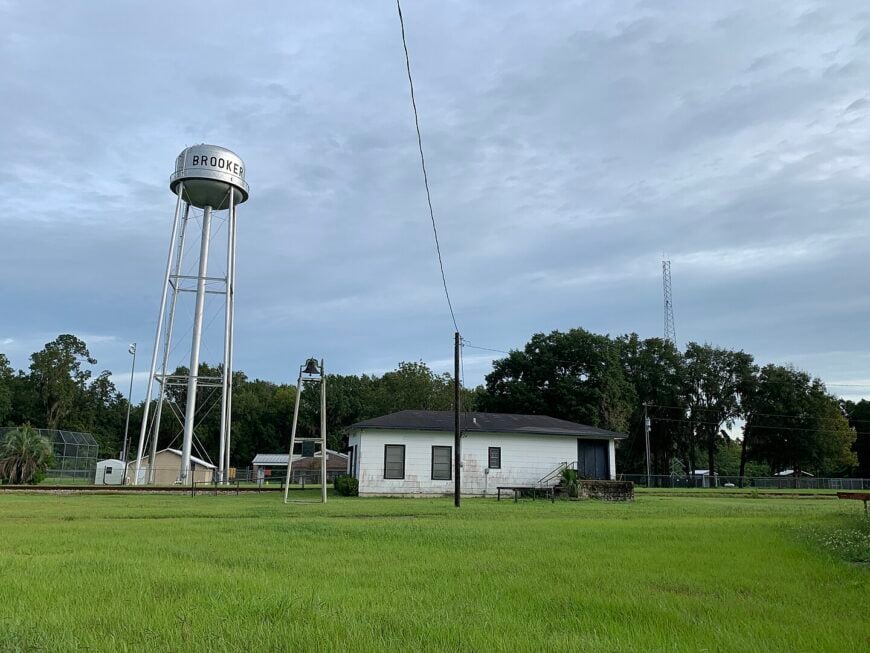
Only 345 residents share Brooker’s roomy acre lots, many bordered by golden peanut fields that turn purple at dusk. Weekend pastimes include fishing at Santa Fe Lake’s hidden coves, browsing produce at the community market, or joining Friday night bluegrass pick-ups behind city hall.
Row-crop agriculture and small-scale timber operations stand as the prime industries, with a handful of home workshops turning out custom cabinets and farm gates. U.S. 301 bypasses the community seventeen miles east, leaving Brooker free from rumbling freight traffic.
Thick pine stands to the north and a patchwork of private hunting leases to the south create a sound buffer that makes midnight feel truly still. The absence of chain retailers or even a stoplight underscores just how removed Brooker is from modern rush.
Where is Brooker?
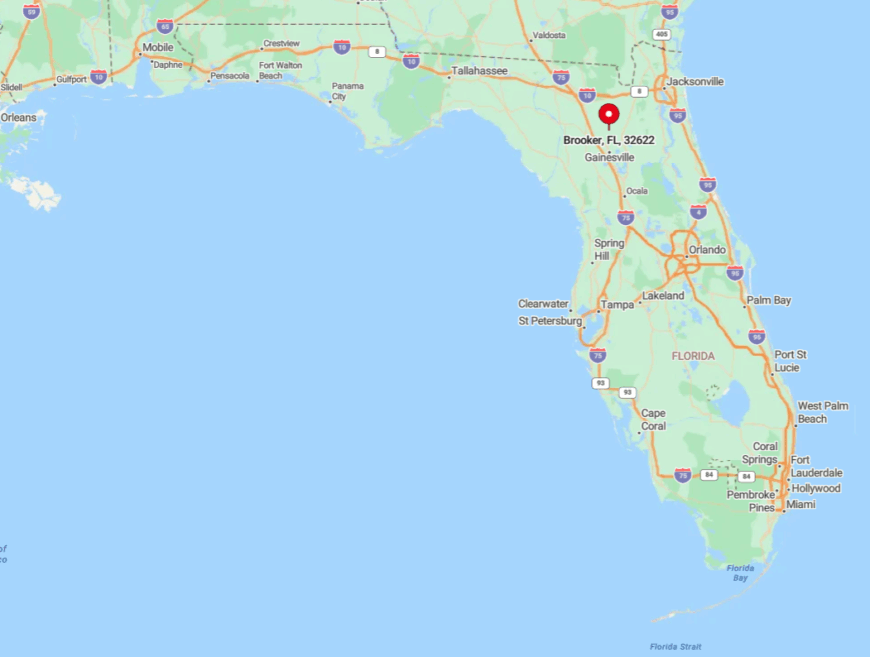
Brooker sits in western Bradford County near the Alachua line, reachable via State Road 235 or 231—both two-lane highways better known for hay wagons than commuters. Its position between the Santa Fe River and New River floodplains thwarts large subdivisions due to soil limitations.
Travelers often exit I-75 at Alachua, then wander northeast for twenty minutes through pine plantations before the landscape opens into patchwork farms and Brooker’s modest water tower appears. GPS service can be spotty along these farm roads, so locals still pass around paper directions.
3. Shady Grove – Taylor County’s Cabin-in-the-Woods Community
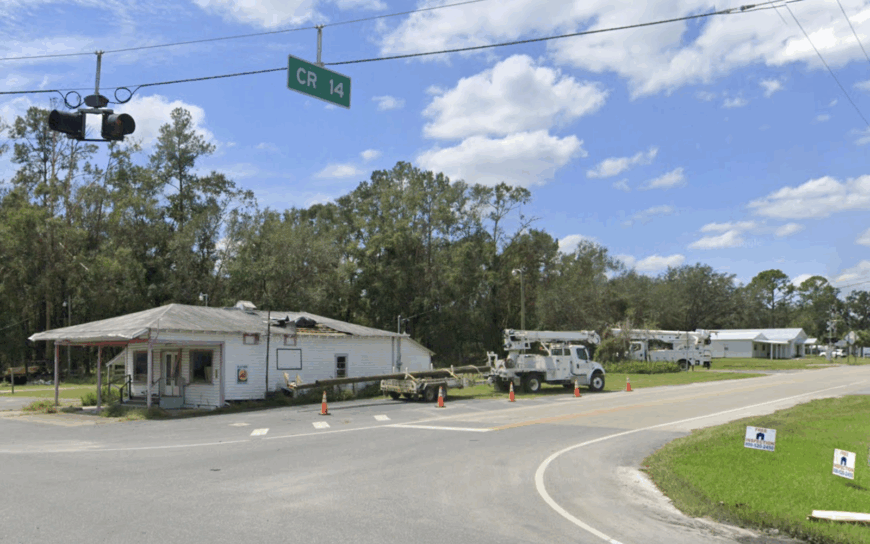
Fewer than 250 people live in Shady Grove, most tucked inside hunting cabins or rough-hewn homesteads down sandy spurs off State Road 14. Residents spend autumn weekends chasing wild turkey, running dogs for deer, or scouting nearby Econfina River State Park’s remote paddling trail.
Timber harvesting and seasonal guiding provide the principal incomes here, with portable sawmills occasionally growling to life before dawn. Over fifty percent of surrounding land remains undeveloped, creating a vast green buffer between Shady Grove and Perry’s modest glow sixteen miles away.
The absence of any commercial strip keeps nighttime darkness absolute, with only generator hum or hoot-owls breaking the silence. Those forested margins lend the community a deep-woods seclusion rare along Florida’s coastline.
Where is Shady Grove?
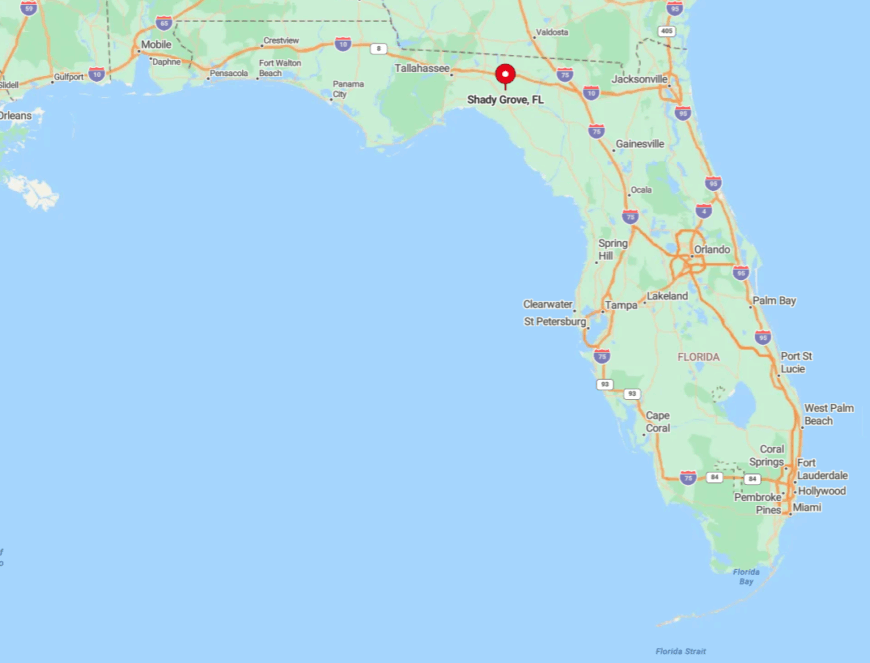
This settlement lies in central Taylor County, about halfway between Perry and the Dixie County line. Long stretches of loblolly and slash pine plantations press against the roadside, muting sound and blocking development sightlines.
Drivers reach Shady Grove via State Road 14, a gently curving blacktop where cellphone bars vanish long before the first mailbox appears. The closest public transportation is a once-a-day Greyhound stop in Perry, underscoring just how isolated the hamlet remains.
2. O’Brien – Suwannee River Limestone Country

O’Brien’s population hangs around 650, scattered along dusty crossroads where mailboxes lean beneath live-oak limbs. Exploration often means snorkeling Peacock Springs’ submerged cave system, picnicking at Little River Spring, or paddling the lesser-known Holton Creek section of the Suwannee.
Cattle ranching, peanut farming, and cave-diving tourism bring in dollars, though many residents still barter produce and labor in classic rural fashion. Limestone sinkholes, sandy soils, and the river’s winding course make large-scale development impractical.
That geological maze, combined with a twenty-five-mile gap to both Lake City and Live Oak, gifts O’Brien a quiet seldom interrupted by traffic. Nighttime here is so silent that the rustle of armadillos in fallen leaves counts as notable sound.
Where is O’Brien?
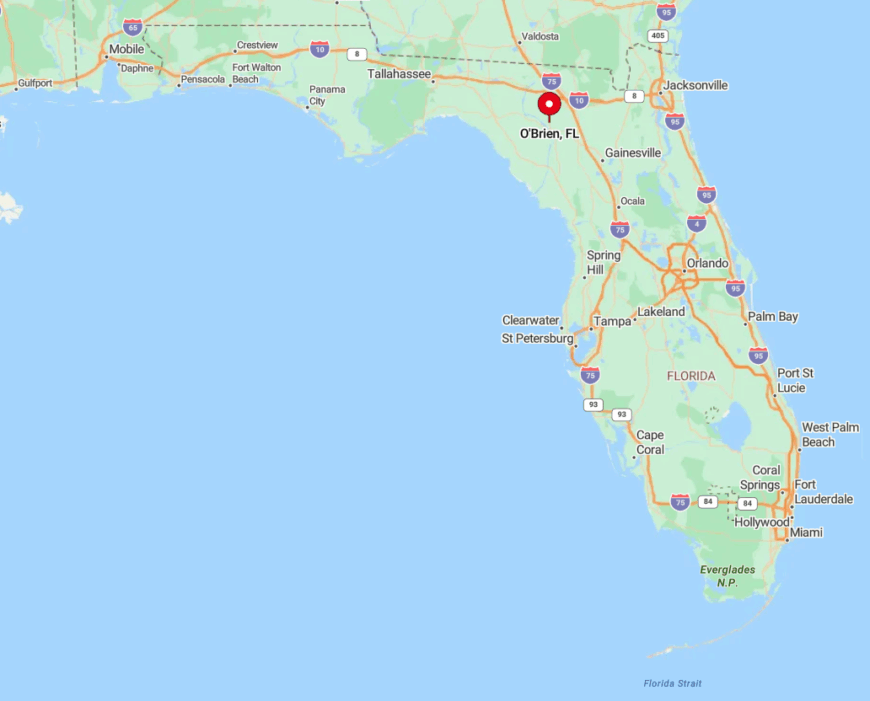
O’Brien sits in southern Suwannee County, two miles west of U.S. 129 and a dozen miles north of the Suwannee’s famed Big Shoals. The river’s floodplain and a lattice of sinkhole lakes limit road options, forcing visitors to approach on narrow county routes that weave around karst depressions.
Most travelers exit I-75 at Lake City, then meander west on State Road 247 until cellphone service flickers and hand-painted produce signs appear. The last stretch, Quilt Loop Road, lives up to its name with patchwork fields stitched together by barbed wire and old oaks.
1. Laurel Hill – Hilltop Solitude on the Alabama Line
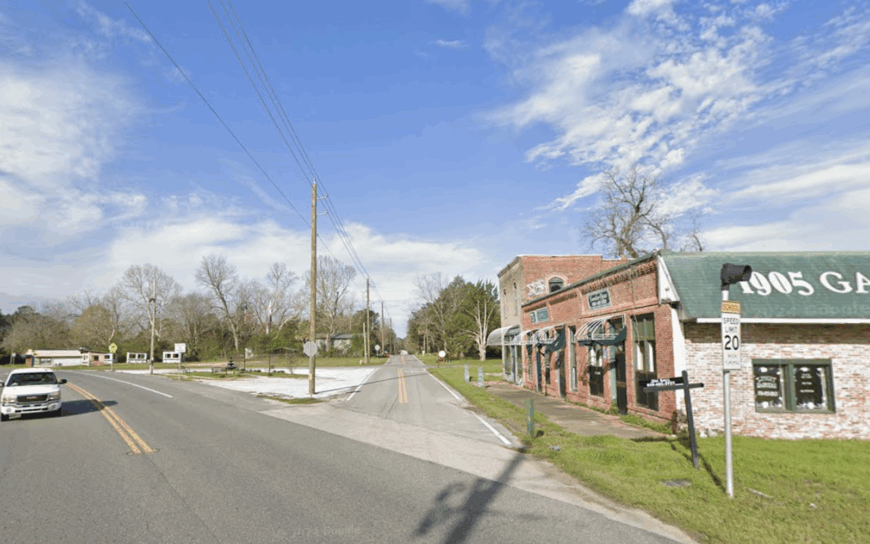
A shade over 550 residents inhabit Laurel Hill, perched 230 feet above sea level—lofty by Florida standards—on gentle uplands of the Wiregrass Hills. Locals pass time trolling Lake Jackson for shellcracker, hiking the Florida Trail’s Alabama Connector, or browsing heritage displays in the 1895 Masonic Hall.
Small-scale poultry farming, longleaf pine management, and a few boutique nurseries provide employment, while many commute south for military jobs at Eglin Air Force Base. Rolling acreage and a buffer of national forest parcels to the south isolate the town from Crestview’s suburban creep.
With U.S. 331 veering west into Alabama and State Road 85 absorbing most through-traffic, Laurel Hill’s streets remain blissfully uncluttered. Its hilltop perch grants wide horizons and, on clear nights, a star field rarely seen in the coastal counties.
Where is Laurel Hill?

Laurel Hill crowns the northern tip of Okaloosa County, just two miles shy of the Alabama border. Longleaf forests owned by timber companies flank the settlement, and minimal crossroads ensure quiet evenings free from rumble strips and brake lights.
Visitors usually leave Interstate 10 at Crestview, then drive eighteen miles north on State Road 85 as the pavement gradually narrows and elevation gently rises. Public transport ends in Crestview, so the only soundtrack on the final stretch is wind rustling through wiregrass.
